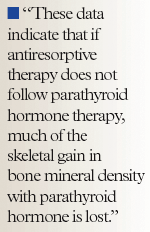- Safety & Recalls
- Regulatory Updates
- Drug Coverage
- COPD
- Cardiovascular
- Obstetrics-Gynecology & Women's Health
- Ophthalmology
- Clinical Pharmacology
- Pediatrics
- Urology
- Pharmacy
- Idiopathic Pulmonary Fibrosis
- Diabetes and Endocrinology
- Allergy, Immunology, and ENT
- Musculoskeletal/Rheumatology
- Respiratory
- Psychiatry and Behavioral Health
- Dermatology
- Oncology
Bisphosphonate maintains BMD gains achieved with parathyroid hormone
One year of bisphosphonate therapy maintains the gains in bone mineral density (BMD) experienced after 1 year of full-length parathyroid hormone (1–84) in postmenopausal women at risk of osteoporotic fracture. The findings were published in the New England Journal of Medicine (2005;353:555–565).
One year of bisphosphonate therapy maintains the gains in bone mineral density (BMD) experienced after 1 year of full-length parathyroid hormone (1–84) in postmenopausal women at risk of osteoporotic fracture. The findings were published in the New England Journal of Medicine (2005;353:555–565).
In the Parathyroid Hormone and Alendronate (PaTH) study, 238 postmenopausal women with T scores and risk factors that placed them at high risk of fracture were randomized to 1 of 4 treatment regimens for 2 years: 1 year of parathyroid hormone followed by alendronate for 1 year; 1 year of parathyroid hormone followed by placebo for 1 year; parathyroid hormone plus alendronate for 1 year followed by alendronate in year 2; or alendronate for 2 years. Parathyroid hormone was administered at 100 mcg daily and oral alendronate was administered at 10 mg daily.

BMD increases from baseline in trabecular bone at the hip were greatest in women randomized to parathyroid hormone (1–84) followed by alendronate (13%; P<.001) and those randomized to combination parathyroid hormone-alendronate followed by alendronate (11%; P<.001).
During year 2, the BMD gains achieved at both the spine and hip with parathyroid hormone (1–84) in year 1 were greatest when followed with alendronate. When parathyroid hormone (1–84) was followed by placebo, women lost trabecular bone at both the spine and the hip.
"These data indicate that if antiresorptive therapy does not follow parathyroid hormone therapy, much of the skeletal gain in bone mineral density with parathyroid hormone is lost," the authors stated in the article.
An earlier finding from PaTH indicated that alendronate used concurrently with parathyroid hormone during the first year of treatment blunted the gain in trabecular BMD with parathyroid hormone alone. Data from years 1 and 2 of the study "...suggest that parathyroid hormone alone followed by alendronate alone may be the preferred method of combining these 2 agents," according to the authors.
The findings with parathyroid hormone in this study are probably applicable to teriparitide given the similar benefits of both agents in increasing areal BMD in previous uncontrolled, observational, and unblinded studies, the authors also stated.
In another study of 126 women with osteoporosis who had been taking alendronate for at least 1 year, daily or cyclic treatment with parathyroid hormone (1–34) plus continued alendronate was superior to continued alendronate alone in increasing spinal BMD (N Engl J Med. 2005;353:566–575). At 15 months, BMD at the lumbar spine did not change significantly by continuing alendronate alone but increased by 6.1% in those randomized to daily parathyroid hormone plus alendronate and by 5.4% in women assigned to cyclic parathyroid hormone and alendronate (P<.001 for both parathyroid hormone groups vs alendronate alone).
